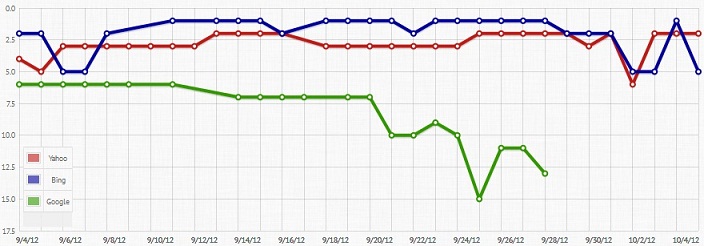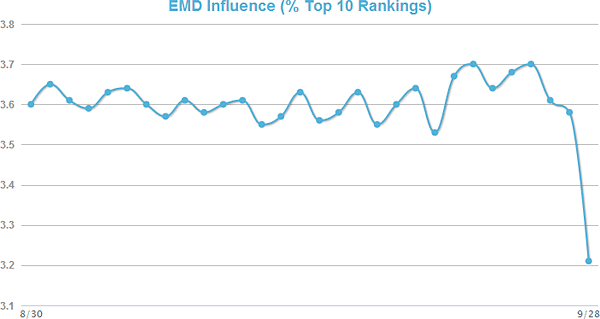Some Exact-Match Domain History
Before September of this year, many webmasters and search engine optimization experts recommended people purchase a domain name containing relevant keywords, often referred to as an exact-match domain (EMD). For example, if someone were looking to start a website about roller coasters, they may have been encouraged to purchase www.rollercoasters.com or www.roller-coasters.com or www.therollercoasters.com.
The point being, many within the search engine optimization field believed using a website’s core keyword in the URL skyrocketed the website’s search ranking for that keyword:
And this belief wasn’t wrong. Here’s a list of actual EMDs and their respective ranking from before September, taken from SEOMOZ.com:
- www.bmicalculatormale.com (#4)
- www.charterschools.org (#7)
- playscrabble.net (#3)
- www.purses.org (#3)
- www.teethwhitening.com (#4)
As you can see, all of them were ranking well for their core targeted keyword.
The problem with EMDs, however, was that the benefit of using a keyword within a website’s domain name greatly outweighed the website’s actual level of quality. Looking at the content of the above sites, other than www.charterschools.org, all of them “appear to exhibit more traditional low-quality signals – aggressive keyword usage, low-authority, spammy link-building, etc. – and seem to have been ranking solely by virtue of their EMDs,” writes Dr. Pete from SEOMOZ.com.
Basically, even if an EMD used duplicate content and excessive keyword spam within its content, the site would still rank well, because that’s how Google’s algorithm worked, for whatever reason. And the strength Google placed upon an EMD meant anyone looking to start a new website was practically forced to continue the EMD trend, because non-EMD websites struggled beneath a sea of EMDs ruling the top-ranking search results.
Then Google changed everything with an update during the last week of September.
Google’s EMD Update

On September 28, Matt Cutts, head of the webspam team at Google, sent out the Tweet pictured above. He went on to Tweet that this update “affects 0.6% of English-US queries to a noticeable degree.”
Obviously, this small update was targeting the previous trend of poor-quality EMDs out-ranking quality non-EMDs, and although the stated number affected was insignificantly small, sites all across the web have reported a sudden drop in their rankings:
On October 5, The Link Builders reported:
Using data from our Microsite Masters account we learned the following about the sites hit by this update:
- Many of these websites were created before April, 2012 (ergo, before the Penguin update)
- These sites were not drastically hit by Penguin, or they’ve recently covered from that update.
- [The website] still has qualities that should have been penalized by Penguin (i.e. high % of EMD anchors)
As a result, all of the sites we were tracking which possessed the (3) attributes above dropped in ranking when the EMD update went live. In multiple instances sites dropped out of the top 100 positions on Google.
The Link Builders then backed up the above statement with a graph depicting a specific campaign “using an EMD for an exact match search query.” Take note of the sudden drops occurring before and around September 28, the day Matt Cutts sent out the EMD update Tweet:

The Link Builders claim the specific website involved in this campaign was “ranking on page 1 for the exact match term last week,” even though it “has many of the elements that were penalized by the Penguin Update: mainly a high concentration of EMD anchors.”
Even with the penalties from the Penguin Update earlier this year, this specific site was still able to ride its EMD all the way to the first page for its respective search term queries.
The Link Builders go on to write, “…this website stopped ranking in the top 100 SERP results since EMD update was rolled out for 100% of the terms that it was previously ranking for.”
Quite simply, the website is dead. And unless it overhauls its SEO copywriting, starts pushing quality backlinks, and creates social contributions, it’s going to stay that way.
But How Hard Were Sites Hit?
On September 29, the day after Matt Cutts’ Tweet, SEOMOZ’s Dr. Pete wrote, “We measured a 24-hour drop in EMD influences from 3.58% to 3.21%. This represents a day-over-day change of 10.3%.”
To give you a visual image, here’s Dr. Pete’s graph showing these changes:

Dr. Pete then goes on to examine the five websites referenced above:
- www.bmicalculatormale.com (#4)
- www.charterschools.org (#7)
- playscrabble.net (#3)
- www.purses.org (#3)
- www.teethwhitening.com (#4)
Again, the parenthetical value shows the website’s ranking on September 28, the day of Matt Cutts’ Tweet. According to Dr. Pete’s data, on September 29, some of these websites “fell out of the top 100 entirely, while others slipped a couple of pages. For example, www.charterschools.org fell from #7 to #23, whereas playscrabble.net dropped from #3 down 18 pages to #183.”
Is The EMD Update Good?
At first glance, yes, the EMD update is great, because it gives quality non-EMD websites a chance to float above poor-quality EMD websites that had been dominating the search rankings.
The problem, though, is that the EMD trend had been alive for so long that even websites providing quality copywriting and satisfactory customer experiences were affected by this update.
One only has to look at the aforementioned www.charterschools.org, a site representing the Michigan Association of Public School Academies (MAPSA). One can assume this professional organization was encouraged to follow the EMD trend, because it would help them rise high enough to attract worthwhile traffic.
Now, due to the update, they’ve dropped from the first page to the third, all because of one algorithm change that swept them under the carpet with all the sites the EMD update had been intended to target. It’s collateral damage, basically.
So What Happens Now?
Honestly, if you own an EMD that has not been updated to the new quality ideals set forth by Panda and Penguin, your website may be doomed to continue sinking through the ranks. It wouldn’t be impossible to bring the site back, but this EMD update is just another layer on top of what Panda and Penguin already demand, and it will definitely be a struggle.
According to The Link Builders, if you recently purchased an EMD, “the following measures can help you avoid getting hit by an existing update or increase the longevity of rankings for prevention against future updates.
- Make sure you’re not over-optimizing your anchors in terms of concentration.
- Refrain from excessive internal-linking using exact match anchors residing on EMD’s or sites in general.”
Lastly, it is well known that Google’s algorithm updates take time to equalize, and websites may see ranking fluctuations for some days or weeks after the update. Let this equalization period run before you start panicking about fallen traffic analysis or ranking drops, because it may not be long before your ranking and traffic rise again.
If you have any questions regarding your website’s current traffic or ranking, please contact us. These changes are incredibly complicated, and we’ll do our best to analyze how this update affected your website.
